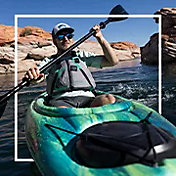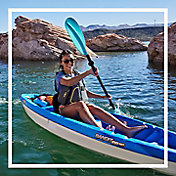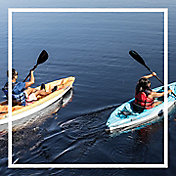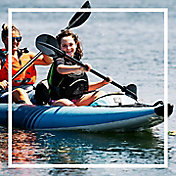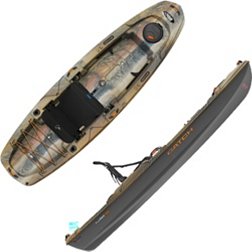Kayak Buying Guide
To find the right kayak for you, you'll need to think about how you'll be using it, where you'll be paddling, and a few other key considerations:
Kayak Hull Designs
A kayak's hull design is the shape of the bottom of the boat. The hull can affect your kayak's stability and performance. There are two types of stability to keep in mind when choosing a new kayak: primary stability, which is how stable the kayak is when you first get in, and secondary stability, which is how stable the boat is once you start paddling. There are a vareity of hull designs to choose from that provide differing amounts of primary and secondary stability along with different levels of performance:
- A flat hull offers a good amount of primary stability and can be a great option for recreational kayaking in flat water conditions.
- A rounded hull features rounded edges that increase speed and secondary stability. This type of hull makes the kayak very maneuverable.
- A v-shaped hull is good for recreational paddling, touring and long-distance trips. This type of hull cuts through the water to help the kayak travel in a straight line, and offers the least primary stability but decent secondary stability.
Sit On vs. Sit In Kayaks
Sit-on-top kayaks are a user-friendly option that is great for beginners. They provide a good amount of stability but may be better for warmer environments because you may get splashed. This type of kayak is a great option for recreational paddling or fishing.
Sit-in kayaks give some shelter from wind and water, and tend to offer more storage space. Sit-in kayaks are often considered the more "traditional" option, and they usually feature details like foot braces.
Think about which style of kayak will work best for you. Once you've decided on a sit-in or sit-on kayak, you should then narrow down your search to different kayak types like fishing kayaks, modular kayaks, or touring kayaks.
Kayak Weight Capacities
Take a look at the weight capacity for each kayak before deciding which option is right for you. A kayak's weight capacity refers to the paddler's body weight along with any other items like coolers and fishing gear.
Kayak Length & Width
As a general guide, the longer and more narrow a kayak is, the faster and straighter it will go. On the other hand, the wider and shorter a kayak is, the more stable and easy to turn. Recreational kayaks usually range between 8ft to 13ft, and are made for small lakes, creeks and rivers. Touring kayaks are usually longer, around 14ft to 18ft, and are designed to take on larger waves in bigger rivers or lakes.


